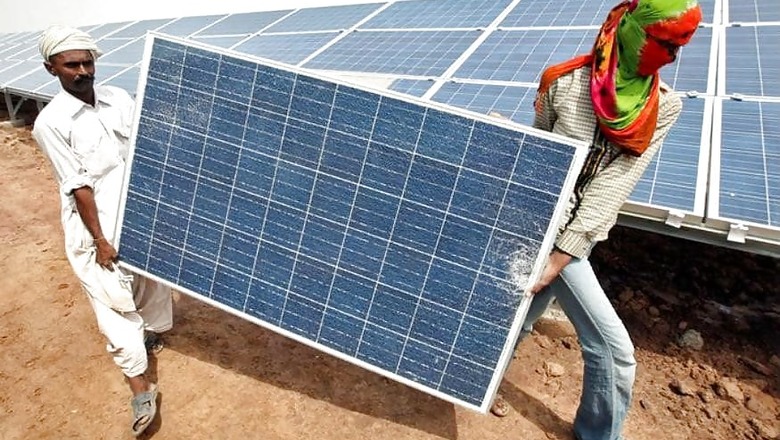
views
New Delhi: After putting its plans for the renewable energy sector on hold in the interim budget, the government must now come up with a multi-dimensional policy framework to put the sector back on growth trajectory and meet the lofty targets it set for itself for the next few years.
Prime Minister Narendra Modi has pushed for a switch to electric mobility that will not only help tackle climate change, but also reduce the dependence on crude that forms a lion’s share of India’s import bill. The government has also set an ambitious aim to set up 500 gigawatts (GW) of renewable energy capacity by 2030 in what could potentially reshape the dynamics of the global energy market.
But to fulfil these objectives, the government must clear the hurdles to reverse the slowdown that has gripped the sector in the last couple of years. The allocation set aside for the Ministry of New and Renewable Energy in the Budget by finance minister Nirmala Sitharaman will determine the seriousness towards the clean energy push.
Solar Slowdown
While the industry is optimistic about the future potential of the sector, the imposition of safeguard duty, the GST and BIS certification issues, project delays and policy reversals, among others, have resulted in slow growth in recent quarters.
The renewable energy sector added about 8600 MW generation capacity in 2018-19, well short of its targeted capacity of 15,602 MW. This was the slowest addition in recent years. In the previous two years, the sector added new capacity to the tune of 11,000-12,000 MW annually, supported by a boom in the solar power sector. Confirming this slowdown, the government set a new capacity addition target of 11,802 MW for the current fiscal.
And yet, the government has set the ambitious target of installing 500GW of renewable energy capacity by 2030. Currently, India runs the largest renewable energy programme in the world and plans to achieve 175 gigawatts (GW) of renewable energy capacity by 2022, the renewable energy ministry said last month.
Of the total 175 GW, the Centre plans to harness 100 GW from solar projects, while wind energy will contribute 60 GW. The country currently has a renewable energy capacity of 80 GW.
Former finance minister Piyush Goyal, while presenting the Interim Budget on February 1, 2019, had noted the increase in India’s installed solar capacity by a factor of 10. He had also said that the India-headquartered India Solar Alliance was a symbol of India’s leadership in renewable energy.
In the 2018 budget, former finance minister Arun Jaitley had noted that the government was committed to put into place a mechanism to purchase surplus solar power by distribution.
The power ministry’s current interest in developing a draft tariff policy to ensure decent electricity charges will also require attention in the 2019 Budget. The previous Budget had allocated only Rs 2.17 billion to the Solar Energy Corporation of India (SECI).
Electric Push
Union minister Nitin Gadkari in a recent interview had reiterated the government’s stand on renewables as well as electric vehicles. “The country is going to adopt EVs in the natural course — be it electric bikes, electric rickshaws, electric cars, trucks or buses and even electric highways. We are working on that front. This will help us to reduce imports and tackle the pollution problem,” he said.
In line with this, the NITI Aayog has been already tasked with preparing a roadmap for the forthcoming years to reduce the use of petrol and diesel vehicles within the next decade. The Centre is equally attempting for a complete transition to electric two-wheelers and three-wheelers by 2023 and 2025.
Gadkari himself is said to be working on projects worth Rs 50,000 crore related to electric vehicles in Delhi. “I have accepted the challenge to make Delhi pollution free in two years,” he had stated.
The government, earlier this year, had announced an outlay of Rs 10,000 crore for the next year towards Faster Adoption and Manufacturing of Hybrid and Electric Vehicles or FAME 2 scheme, but it must also focus on funding the manufacturing of lithium-ion batteries for charging infrastructure.
When asked about the deficiency, Gadkari noted in an interview that the demand of electric vehicles will automatically necessitate the manufacturing of batteries.
Today, lithium-ion batteries are imported due to lack of local manufacturing. The previous Budget had increased the tariff rate of customs for lithium-ion batteries from 10% to 20%. The import duty on them, however, remained the same at 10%.
Industry Demands
In view of all of the above, the 2019 Budget has a lot to take into consideration. It must prioritise its interest while also keeping in sight further adverse effects of climate change in the near future.
Apart from the increased allocation, the government would also need to incentivise investment. Recently, representatives from the climate change sector had met Sitharaman, seeking enticements for electric vehicles as well as for the renewable energy sector.
Major suggestions made to the finance minister included streamlining of the land acquisition process, creation of green technology acceleration fund, incentivising domestic manufacturing of solar energy equipment and fiscal incentives for development of the electric vehicle industry.

















Comments
0 comment